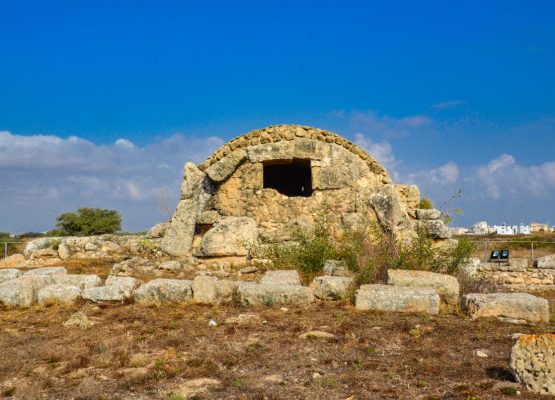
Fascinating Burial Customs
This collection of tombs near Salamis are presumed to be royal given their scale and splendour and so have also been dubbed the Tombs of the Kings.
The great burial site is divided into two sections yet has never been fully excavated since its exact boundaries are still unknown. One area contains the tombs of royal personages and high-ranking inhabitants of Salamis, a second area in which ordinary citizens were buried.
Studies indicate that the tombs on site date mainly to the 7th and 8th century BC, and were continued to be used until the 4th century AD. However, some are believed to go back as far as the 11th century BC, suggesting that the cities of Salamis and Enkomi coexisted for some time.
The burial customs evident from these tombs are similar to those described by Homer in The Iliad.
The horse-drawn hearse would be driven down the sloping dromosto the entrance, along with other horse-drawn chariots, before the body was raised onto a funeral pyre and cremated. The ashes were then stored in a bronze cauldron inside the chamber, along with opulent grave goods including furniture decorated with ivory and amphorae containing olive oil or honey.
Horses pulling the hearse were also sacrificed in honour of the deceased. The skeletons of horses, buried complete with chariots, can still be seen at the entrance to several of the tombs, also sacrificed as grave goods to ensure their owners were able to ride their favourite mount in the afterlife. The wooden frames of these chariots have decayed but have left impressions in the soil and their metallic fittings are still in position.
Human sacrifices were also made, most likely servants, who could in turn continue to serve their masters in the afterlife.
All the tombs are numbered, and here is a description of a few for sightseers to read up on before visiting this site.
TOMB 50
A matter of debate amongst scholars over the years, perhaps both the most interesting and also the least typical of the Royal Tombs is this one with a domed roof, that can be seen from the road as you approach the site.
It has two chambers, a large vaulted chamber, which was added in Roman times, and a smaller chamber, lying to the west, which is much older. It was used as a chapel from approximately the 14th century onwards and has been described as having been an altar in the smaller chamber, while the larger chamber was found to contain an icon of St. Catherine of Alexandria, who according to legend was imprisoned here after converting to Christianity.
As a result, its appearance differs significantly from the other tombs, although it does have a characteristic dromosleading down to it and the skeletal remains of two sacrificed horses were found during excavation.
Some of the stones used in its construction were taken from other tombs, and part of the cornice used in the chapel matches that in nearby Tomb 47.
TOMB 47
Two burials were found in 1964 excavations in what is the largest tomb, located next to the museum.
The first, where two horses have been sacrificed, one of which appears to have panicked and broken its own neck by twisting around the chariot pole. The horses were wearing leather frontlets and blinkers with gold-covered headbands, found when the skeletons were excavated. There was no trace of the chariot in this burial, and it was probably used as a hearse and placed with the body.
At the second burial, about fifty years later in around 650 BC, a total of six horses were sacrificed and buried at the entrance. They would have drawn between them a four-horse carriage (quadriga) and a two-horse biga, yoked in pairs. They wore blinkers of ivory and bronze decorated with lotus flowers and anthemia.
A spacious cemented dromos leads to the monumental temple in front of the chamber built of enormous well-dressed stones.
TOMB 79
The richest finds located are from this very tomb, just south of tomb 47 – thrones embellished with ivory and silver, an ivory-inlaid bed frame, earthenware jars and a large bronze cauldron decorated with the heads of griffons and sphinxes.
Evidence shows that it received two burials in a short space of time towards the end of the 8th century BC. When the second burial took place, it seems that the remains from the first were simply pushed further back in the burial chamber to allow the later, richer burial to take place.
A four-horse chariot had its wheels held by magnificently long lynch pins, with a bronze sphinx head at one end and a hollow bronze figure of a warrior at the other wearing a crested helmet, body armour inlaid with blue glass and a long sword hanging from a baldric.
It was later re-used for burials during the Roman period, with niches for sarcophagi being carved into its walls during this time. When this tomb was excavated, Roman pottery, lamps and the remains of clay sarcophagi were also found inside the chamber.
Necropolis of Cellarka
There are many more wonderfully impressive tombs to admire at this large site.
Furthermore, the necropolis of Cellarka is also part of the Royal Tombs concentration, set about 400 metres away, where the common town people were buried.
A set of much smaller tombs, these were cut into rock with staircase access. Finds here indicate that sacrifices and feast ceremonies also took place in the dromos before the burials, however revealing more modest grave goods.
Visit Today
Even if you are not fascinated by burial customs, the Royal Tombs is certainly an intriguing attraction to spend a few hours exploring – it will definitely broaden your imagination.
The site also houses a small museum displaying discovered artefacts and remains of some grave goods – an ivory inland throne and bed, horse bridles, numerous objects in precious metals and other items of tack are on display for visitors to view.





